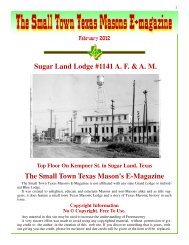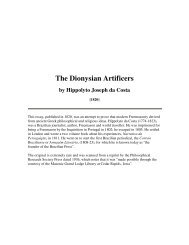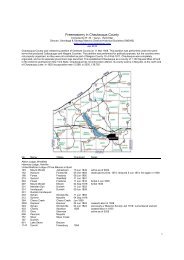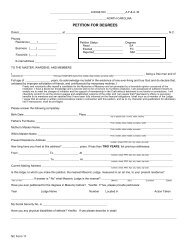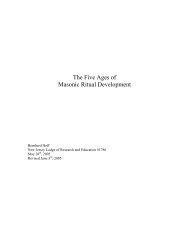Entered apprentice info - MasterMason.com
Entered apprentice info - MasterMason.com
Entered apprentice info - MasterMason.com
You also want an ePaper? Increase the reach of your titles
YUMPU automatically turns print PDFs into web optimized ePapers that Google loves.
nowhere in our ritual are we told much of anything as to why all these things are so; how the<br />
Lesser Lights came to be; what their hidden, covered, secret, symbolic meaning is.<br />
And you shall search through many a Masonic volume and tome and find no more light on the<br />
Lesser Lights than the ritual gives. Mackey, the great authority, is unusually brief, and beyond<br />
drawing a parallel to the use of the seven branched candelabra as described in the Great Light,<br />
and stating that their use in Masonry is very old, they appearing in print in references to Masonry<br />
in the seventeenth century, adds practically nothing to the ritual explanations.<br />
And yet it could not be possible that so important a symbol could have no more soul than is given<br />
in the few words we devote to it. It seems obvious that it is one of those symbols in Freemasonry .<br />
. . of which there are so many! . . . which the individual brother is supposed to examine and<br />
translate for himself, getting from it what he can, and enjoying what he gets in direct proportion<br />
to the amount of labor and thought he is willing to devote to the process of extracting the<br />
meaning from the outer covering.<br />
Let us dig a bit together; labor in <strong>com</strong>pany is lightened always; a burden shared is a burden<br />
halved!<br />
Immediately after the Lesser Lights are named, our attention is directed to the fact that they are<br />
in a triangle about the Altar. In some Jurisdictions they are closely about the Altar; in others, one<br />
is placed at each of the stations of the three principal officers.<br />
In some lodges the three Lesser Lights form a right, in others an equilateral; in others an<br />
isosceles triangle. What is uniform through out the Masonic World is the triangular formation<br />
about the Altar; what is different is the shape and size of the triangle. Of course, it is not possible<br />
to place three lights to form anything else but a triangle, or a straight line; they cannot be made<br />
to form a square or a star. Which brings us to the first place in which to sink our Masonic shovel;<br />
why are there three Lesser Lights, and not two or four?<br />
There are a number of reasons. Any thinking brother has already discovered that there is "Three"<br />
throughout the whole system of Ancient Craft Masonry; three degrees, three steps, three ancient<br />
Grand Masters; and so on. It will be no surprise to recall that three is the first of the great Sacred<br />
Numbers of the ancient Mysteries, and that it is the numerical symbol of God. Not, if you please,<br />
because God was necessarily considered triune.. While many religions of many ages and peoples<br />
have conceived of Divinity as a trinity, the figure three as a symbol of God is far older than any<br />
trinitarian doctrine. It <strong>com</strong>es from the triangle, which is the first possible figure made up of<br />
straight lines which is without either beginning or ending. One line, or two lines have ends. They<br />
start and finish. The triangle, like the square or the five or more sided figure, has no loose ends.<br />
and the triangle is the first of these which can be made; as God was always considered as first;<br />
and also as without either beginning or ending, the triangle itself soon became a symbol of Deity.<br />
Sun worship was among the first of religions; let him who knows lay down the facts as to whether<br />
sun worship preceded fire worship, or fire worship that of the sun. To us it does not matter. Sun<br />
worship is far, far older than any recorded history; it goes back, far back, into the first dim mists<br />
which obscure the very first beginnings of intelligence. So it was only natural that the early<br />
worshipers should set a light beside their Altar or Holy place and name it for the sun.<br />
Ancient peoples made much of sex. Their two greatest impulses were self-preservation and<br />
mating. Their third was protection of children. So enormously powerful were these impulses in<br />
primal man, that not all his civilization, his luxury, his <strong>com</strong>plicated and involved life, have<br />
succeeded in removing these as the principal mainsprings of all human endeavor. It was natural<br />
for the savage worshiper of a shining God in the sky to think he, too, required a mate; especially<br />
when that mate was so plainly in evidence; the moon became the Sun's bride by a process of<br />
reasoning as plain as it was childlike.<br />
Father, Mother . . . there must be a child, of course.<br />
29



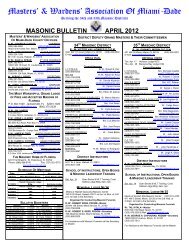
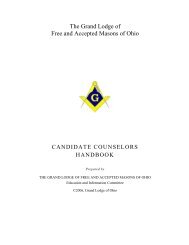
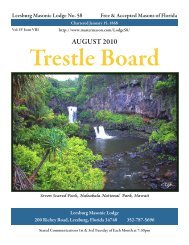

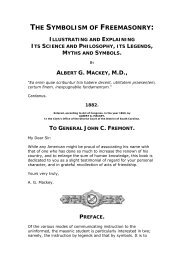

![Junior Grand Warden Views [2005-2] - MasterMason.com](https://img.yumpu.com/36303049/1/190x245/junior-grand-warden-views-2005-2-mastermasoncom.jpg?quality=85)

